

The Internet of Things and Beyond: Rise of the Non-Human Actors: Social Sciences & Online Behavior Journal Article. Abstract In the past, it was rare for non-humans to interact with each other without any involvement by humans, but this is changing.
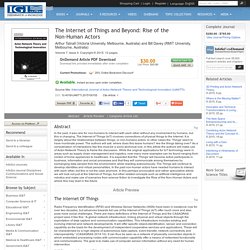
The Internet of Things (IoT) involves connections of physical things to the Internet. It is largely about the relationships between things, or non-humans actors. In other cases the ‘Things' seem to have inordinate power. The authors will ask: where does this leave humans? Article Preview. Ready or not, IoT is here and evolving - Ai Group Blog.
Some say it’s here, not quite there, a marketing hype or just a passing phase.
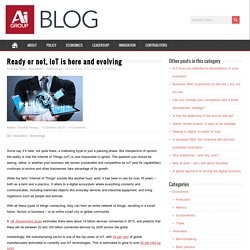
But irrespective of opinion, the reality is that the Internet of Things (IoT) is now impossible to ignore. The question you should be asking, rather, is whether your business will remain sustainable and competitive as IoT (and its capabilities) continues to evolve and other businesses take advantage of its growth. While the term “Internet of Things” sounds like another buzz word, it has been in use for over 15 years – both as a term and a practice. It refers to a digital ecosystem where everything connects and communicates, including inanimate objects like everyday devices and industrial equipment, and living organisms such as people and animals. With all these types of things connecting, they can form an entire network of things, resulting in a smart home, factory or business – or an entire smart city or global community. But what do businesses think? The following two tabs change content below. Mapping the Internet of Things - IoT Central. You would think that in this day and age of infographics that finding a map laying out the ecosystem of the Internet of Things would exist.

Surprisingly, a Google search doesn’t appear to return much. Neither does a Twitter a search. Recently though I found two worth sharing. There is more value in the IoT economy than Big Data analytics. By Rawn Shah, The Economy of Things report just released by the IBM Institute for Business Value(IBV) gives a glimpse at what is possible when devices are enabled over a network.
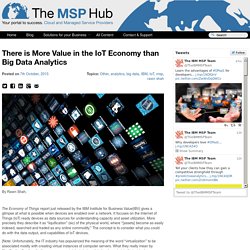
It focuses on the Internet of Things (IoT) ready devices as data sources for understanding capacity and asset utilization. More precisely they describe it as “liquification” (sic) of the physical world, where “[assets] become as easily indexed, searched and traded as any online commodity.” The concept is to consider what you could do with the data output, and capabilities of IoT devices. [Note: Unfortunately, the IT industry has popularized the meaning of the word “virtualization” to be associated mostly with creating virtual instances of computer servers. By abstracting IoT device capabilities and output, the report suggests that you “can create liquid marketplaces of physical assets by enabling real-time discoverability, usability and payment.” $2.5 million per minute… Internet of Things spending set to skyrocket. Worldwide IT spending is forecast to surpass US$3.6 trillion in 2016, a 1.5 percent increase from 2015, according to Gartner.
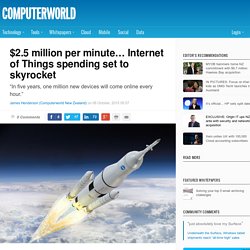
The IT industry is being driven by digital business, and an environment driven by a connected world, with Gartner predicting that spending on Internet of Things (IoT) hardware will exceed US$2.5 million every minute in 2016. In five years, one million new devices will come online every hour, claims Peter Sondergaard, senior vice president at Gartner and global head of Research.
Sondergaard says these interconnections are creating billions of new relationships but are not driven solely by data, rather algorithms. “Data is inherently dumb,” Sondergaard adds. Internet of Things That Lie: the future of regulation is demonology / Boing Boing. Volkswagen's cars didn't have a fault in their diesel motors -- they were designed to lie to regulators, and that matters, because regulation is based on the idea that people lie, but things tell the truth.

The Internet of Things is a world of devices (buildings, legs, TVs, phones) that can be programmed to sense and respond to their environments. These are things that don't submit to scrutiny: they fight back. You know the old joke about a broken photocopier that works perfectly when the repair tech shows up? Xerox could build one of those and maximize service-call revenue. As Marcelo Rinese from the Institute for Ethics and Emerging Technologies writes, technological tests have to be fair, transparent, and well-defined -- which makes them easy to detect and defeat. It's a demonological approach to science, where the universe is perverse and wants to hide its secrets from you. VW's Cheating Proves We Must Open Up the Internet of Things.
It’s been a rough year for the Internet of Things.

Security researchers uncovered terrifying vulnerabilities in products ranging from cars to garage doors to skateboards. Outages at smart home services Wink and Google’s Nest rendered customers’ gadgets temporarily useless. And the Volkswagen emissions scandal, though not precisely an Internet of Things issue, has exposed yet another issue with “smart” physical goods: the possibility of manufacturers embedding software in their products designed to skirt regulations. And those are only the most immediate concerns. The IoT Security Foundation, aimed at securing the Internet of Things, opens its doors.
The Internet of Things Security Foundation officially opens its doors today, September 24th, with the broad goal of securing the Internet of Things in an open manner, to allow the industry to flourish.
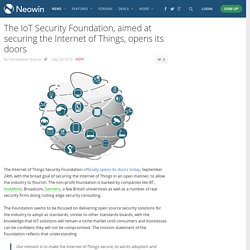
The non-profit foundation is backed by companies like BT, Vodafone, Broadcom, Siemens, a few British universities as well as a number of real security firms doing cutting edge security consulting. The Foundation seems to be focused on delivering open source security solutions for the industry to adopt as standards, similar to other standards boards, with the knowledge that IoT solutions will remain a niche market until consumers and businesses can be confident they will not be compromised. The mission statement of the Foundation reflects that understanding Our mission is to make the Internet of Things secure, to aid its adoption and maximise its benefits.
Source: Bit-Tech. Connected mascara? L'Oreal explores the internet of things. The technology could allow the beauty company to give connectivity to "dumb" objects like lipstick or mascara, giving it a new way to track customers.

The company’s head of digital and media for Australia and New Zealand, Christophe Emery, said marketing via connected make-up could become as vital as on mobile. You can imagine there’s a great opportunity to have make-up as connected devices as well, creating a territory for ongoing customer engagement. Speaking to Marketing during the Dreamforce conference in San Francisco, Emery said: "There is a lot of development happening internally.
"There is definitely a big focus. These products, for most consumers, are in their bags every day and are almost as personal as their mobile device. "You can imagine there’s a great opportunity to have them as connected devices as well, creating a territory for ongoing customer engagement. Emery declined to go into detail on L’Oreal’s research, but said the firm would be making future announcements. Lord of the things: Homewares and internet just don’t mix. God help us all, Tamagotchis are back.
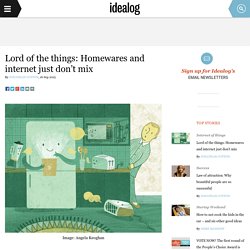
The annoying “virtual pets” that sprung to such voracious life in the 1990s, then died, forgotten and neglected, have returned from their shoebox graves, this time with a twist. Now, powered by the internet-of-things, Tamagotchi 2.0s can communicate between themselves and over the internet, adding a whole new dimension to arguably the most one-dimensional toy in human history. I’m imposing a media ban on my children until this fad passes. You go ahead, we’ll catch up later on. In The Future We Will Fall Madly in Love with our Toasters. …and why the future of the Internet of Things will be the Cute Home, not the Smart Home.
Ever since my tamagotchi died in high school I’ve been wondering what the next digital artefact is that I’ll mourn for. We anthropomorphize so many things in our lives — from pets to furniture. It’s a natural instinct to build meaningful relationships with the things we integrate into our lives. It’s not our fault, it’s just how out brains are wired. And so — if I peek into the future I’m fascinated by a few different pieces of the puzzle coming together: artificial intelligence getting as “smart” as small mammals, cheap on-board circuitry and the increasing smarts from UI designers to build systems we actually care about. Artificial Cuteness. The Internet of Way Too Many Things. Among the items at Open House: Whistle, $99. This attaches to your pet’s collar and allows you to set a daily activity goal customized to your dog’s age, breed and weight — and then share that information with other pet owners via social media.
Refuel, $39.99. A black plastic sensor-enabled ring that monitors your propane tank levels and sends you notifications when propane is low so that, its inventor says, you’ll never “get caught off guard by BBQ bummer again.” Photo 94Fifty, $199.95. Internet of Things and the 5th Generation Mobile Network - IEEE Internet of Things. Roberto Minerva September 8, 2015. Making the Internet of (Farm) Things Real in Montgomery County, Md. Suburban Washington, D.C., might not spring to mind as a top U.S. farming community—but Montgomery County, Md., is embarking on one of the most innovative and unique initiatives in agriculture today.
The county’s Thingstitute, a first-of-a-kind living laboratory for Internet of Things (IoT) technology projects, is starting an agriculture testbed to help farmers use data to become more productive, prosperous and viable—and Microsoft CityNext is proud to be its lead partner. While the agriculture testbed is in its earliest phase, its aspirations are great, according to Dan Hoffman, Maryland County’s chief innovation officer and Thingstitute leader: “The idea behind the testbed is to determine what types of services and support we can provide to county farmers using technology. Farmers care what’s happening at their farms—ground temperatures, weather conditions, the more local the better. It’s a tall order but Maryland County makes agriculture a priority. Complimentary Research.
To get access to any of Compass Intelligence's complimentary research or to review samples of our market research, please click here to request (provide title and interest). During the first quarter of 2015, the TOP U.S. carriers and mobile vendors either launched or announced their plans to offer mobile services targeted at small and medium-sized businesses (SMBs). Q1 was a big quarter for business or enterprise-related announcements and partnerships. Included among these new offers is Sprint's Workplace as a Service (WPaaS) that includes a wireless component as well as AT&T's Mobile Office Suite, and T-Mobile's Un-carrier for Business. These newly announced service packages are positioned as productivity and collaboration enhancement tools to help SMBs boost operational efficiency and effectiveness.
Anticipate, sense, and respond: Connected government and the Internet of Things. Introduction Long before the advent of today’s wrist wearables, Hollywood’s James Bond was using his watch to measure radioactivity and receive messages from headquarters.1 And before any company began prototyping connected cars, he careened through a high-speed chase where he controlled his car from the backseat via mobile phone—augmented by sensors that triggered fixes for safety issues such as flat tires and a video feed that alerted him to obstacles.2 Previously the domain of fantasy, such devices are becoming reality and even mainstream: Smart watches help verify identity and pay for goods, alarm clocks know the current traffic, and smart glasses provide instant access to expert advice.
What were once imaginative toys for a tech-savvy spy may soon be a new class of tools for public servants more generally. “This wave of technology has more chance of reimagining whole swathes of the world than anything we’ve seen before.” Why big companies struggle against 'internet of things' boom.
Neha Alawadhi, ET Bureau Aug 26, 2015, 10.06AM IST (Big companies are facing…) Anticipate, sense, and respond: Connected government and the Internet of Things. The Internet of Things in automotive. Executive summary Our cars have been connected for years, in ways that by now seem routine: They seamlessly link to our smartphones, register real-time traffic alerts, stream our Spotify playlists, and offer emergency roadside assistance at the touch of a button.
KLM has invested in Undagrid, an 'internet of things' startup - Business Insider. ScreenshotCEO of Undagrid, Rolf van de Velde. Dutch 'Internet of Things' startup Undagrid has raised an undisclosed amount of seed funding from KLM (Royal Dutch Airlines), Amsterdam airport Schiphol, Rabobank and the Delft University of Technology - who together manage an investment fund dubbed Mainport Innovation Fund (MIF). The Internet of Things: The Impact on the Travel and Hotel Industry - By Alan Young President, Puzzle Partner Ltd. The Internet of Things (IoT) is a relatively large topic that is widely circulating around these days, but I think it is very important to point out its practical implementations. According to HOSPA in 2013 there was one device connected to the internet per person on earth. They forecast that by 2020, this number will increase to 9 devices per person. Retailers Show Staggering Optimism About Internet Of Things, New RSR Research Report Finds.
Revenue Beats Savings IoT is more about driving differentiation than about saving money Miami, FL (PRWEB) August 27, 2015. Monetizing the Internet of Things in the electronics industry. Monetizing the Internet of Things (IoT) has been a hot topic during 2015. How the IoT Will Redefine Data-Sharing and Privacy. Imagine products such as a medicine cabinet or refrigerator throwing off a constant stream of data points about a consumer. By the end of this decade, there will be over 50 billion connected objects -- approximately six objects for every person on the planet. The Promise of the Industrial Internet of Things - Industrial Internet Consortium. By Gregory Conary, Senior Vice President of Strategy for the Industry Business, Schneider Electric On Schneider Electric's blog, I have written about our Industrial Internet of Things (IIoT) strategy, where we stand on the topic and how we are ensuring the value of what we are doing in this space is clear and relevant to you.
Today I want to expand on this topic, move away from talking about products and solutions, and discuss the business opportunities we are seeing emerge from this megatrend. First, two statistics which seem to be quite telling: Why the Internet of Things will be worse than a zombie apocalypse. It all sounds so pleasant, this "Internet of Things" just around the corner, when the objects of our world will be armed with programming that lets them invisibly communicate with one another. Your freezer will know you're light on Häagen-Dazs and alert the grocery store to add two tubs to the next order! Your car will drive itself, by sharing its exact position and speed with the road and with all the other cars! Your wallet will talk with all the items in your Home Depot cart, and pay on the way out the door — no waiting in line! Internet of Things as driver for a Circular Eco...
Why the Internet of Things is about the data, not the 'Thing' The “Internet of Things” Is a Bad Idea. Theconversation. Why the Internet of Things will be worse than a zombie apocalypse. The Internet of Things and supply chain management. Internet of Things will Increase Productivity. Innovation Enterprise. Everything You Know About the Internet of Things is Wrong — Backchannel. Sherlock Holmes & the Internet of Things. Will the internet of things result in predictable people? Welcome to The Internet of Compromised Things. Here's why the Internet of Things has been compared to the Industrial revolution. When the Internet of Things goes too far. Meet Ether, The Bitcoin-Like Cryptocurrency That Could Power The Internet Of Things. Welcome to The Internet of Compromised Things. Internet of things makes the smart connection between efficiency and profit.
The internet of food: why your steak might have come from a connected cow.